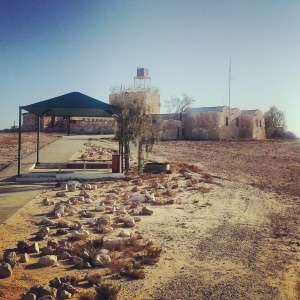Although the course may have finished, the exploring never stops – all I need is an excuse. My friend Ben happily provided that when he suggested we go on a trip down to the Negev desert, and I thought that this would be an excellent opportunity to check out a few places that I had been meaning to visit.

We began our day at the desert oasis of Ein Avdat. It is a popular hike, because it is quite easy, and utterly beautiful. the combination of the springs with the bleak desert scenery is really very special. Unfortunately, the only way to do the whole hike is by having a car/bus pick you up at the other side (there is a section which is only one way), so we missed out on the very final part of the hike, but we certainly got to enjoy the majority of it.

As we were around at a quiet time, we also had the pleasure of seeing some of the local desert wildlife taking advantage of the oasis. There are many ibexes wandering the Negev and the ones we encountered were relatively unphased by our presence. It was wonderful to observe them.
Having stretched our legs, we headed up to the nearby Sde Boker Field School, which houses the graves of David Ben Gurion, the first Prime Minister of Israel, and his wife Paula. Nearby is the small hut to which Ben Gurion retired, famously choosing to live a life of relative simplicity on a kibbutz as part of his socialist ideology, instead of occupying a grand house which many felt he was due. He also chose specifically to live in the Negev, an area which he saw as the future of Israel; vital that it be developed in terms of agriculture and settlement for the state’s survival.

His hut is quaint, kept as it was when he lived there. It is particularly interesting to see the gifts he received from other statesman (having just returned from a trip to Burma where we saw photographs of his visit there, it was touching to see the Buddah he received in a prominent position). The library is also quite amazing, giving you a scope of quite how well read Ben Gurion was, and how many languages he commanded. There is no doubt that he was a very impressive man.
Leaving Sde Boker, we popped in to a couple of small farms that were not too far away, both of which specialise in the manufacture of Goat’s Cheese. We particularly enjoyed the Naot Farm which also has options to stay, should you wish to get away from it all.

We then headed west as I was keen to check out Mitzpe Revivim, one of the first Jewish settlements in the Negev, in the modern period. This small agricultural settlement had a significant impact on the Negev being awarded to Israel as part of the partition plan; the stories that accompany it are perhaps more impressive than the buildings which remain (the modern kibbutz has moved slightly away from the original site).
We had a bit of time before heading home, so we briefly stopped off at the Besor Hanging Bridge, the Maon ancient Synagogue, and the Black Arrow memorial (read more about these in my previous blog post), before returning to Tel Aviv. It is amazing how close we live to the desert, and it was wonderful to take advantage of it. Thanks, Ben!